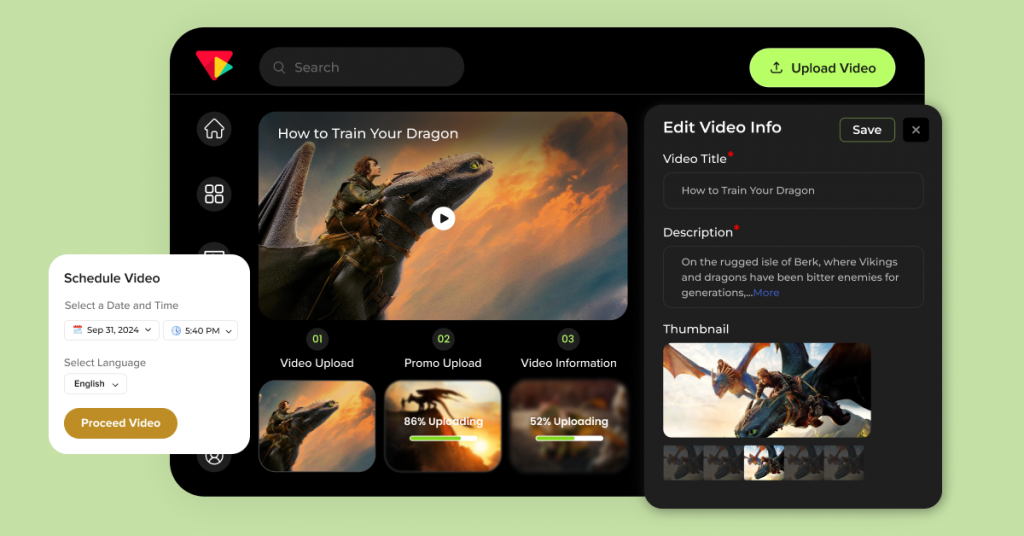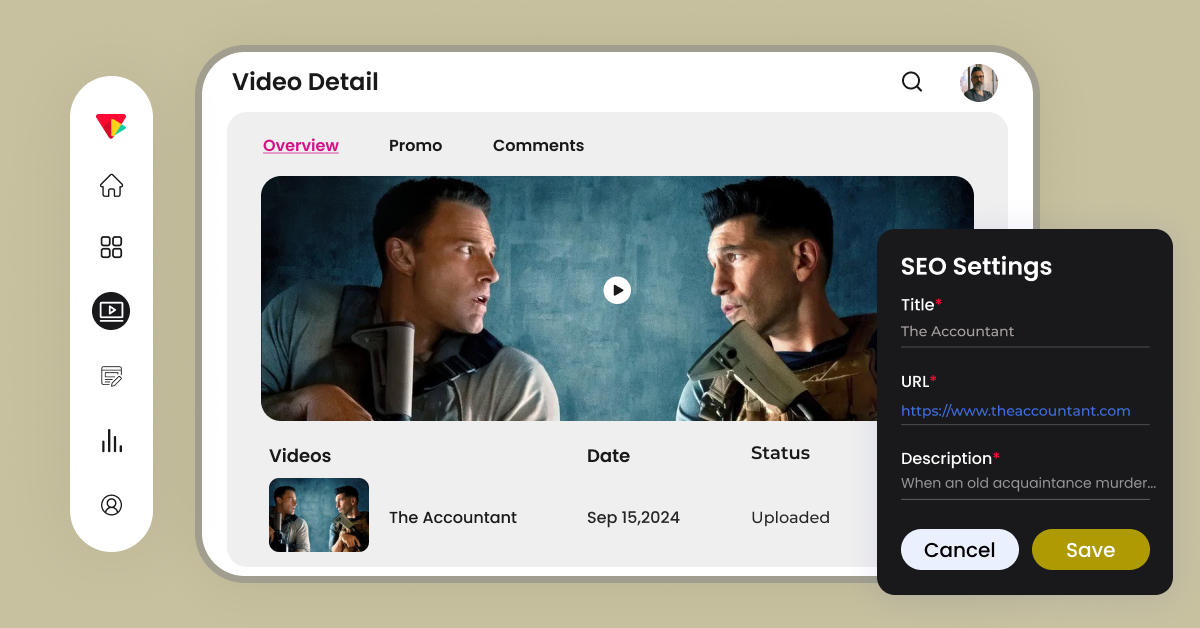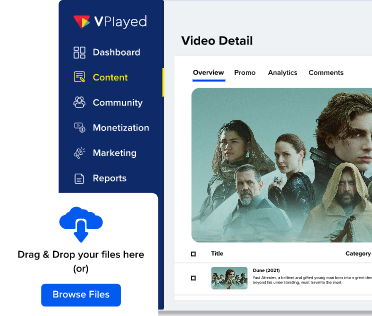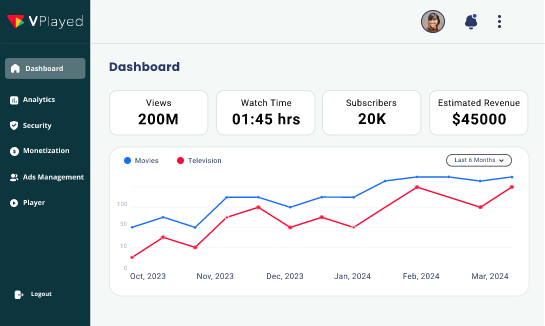Upload, Manage, and Distribute Your Video Content through centralized video CMS with 1000+ Features & 10+ Revenue Models.
Book a Free DemoEnterprise Video Content Management: What You Need To Know In 2026

Summarize this article via
Video content has become a linchpin for businesses in training, communication, marketing, and several business processes. 95% of businesses use video as a marketing tool in 2026, according to a report from Wyzowl.
Remaining businesses that don’t use video (for marketing) say they’ll start using it by the end of 2026. This stat highlights the barriers, such as time constraints and a lack of centralized video storage, for video adoption.
This is where Enterprise Video Content Management System (EVCM) helps businesses to host, manage, and distribute video content for purpose-driven campaigns.
This blog breaks down the benefits of an EVCM system, focusing on how it makes lives easier for businesses. Also, we’ll cover what to consider while choosing your ideal system.
Let’s dive in.
- Fully Customizable
- Lifetime Ownership
- On-Premise/On-Cloud
- 100% White-label
- Zero Revenue Share
- Hire Developers
Table of Contents
What is an Enterprise Video Content Management?

Enterprise video content management is an efficient approach to organizing, managing, and distributing video content from centralized storage.
Think of it as a collaborative tool for storing and distributing video content. Multiple users can access, collaborate, edit, and publish video content from a central dashboard, streamlining workflows and ensuring business efficiency.
The hallmark of an enterprise video management software lies in providing a centralized storage for video assets. Like a typical content management system, it enhances the discoverability and dissemination of video assets.
The EVCM system stores different versions of a video, thereby facilitating version control, cross-team collaboration, approval workflows, and more.
The Key Benefits of an Enterprise Video Content Management
With an increasing demand for video content and the need to make the most out of it, enterprises need to have a video content management system in place.
Employing enterprise video content management allows you to simplify video-searching activity; employees/learners can easily find a particular training video among innumerable other files.
While you’re reading this, you may be wondering: what does it bring specifically to our organization’s table? Let us list the benefits one by one:

1. Optimize Resources with Centralized Storage
As the name implies, enterprises can drive home this benefit, a centralized storage from which authorized users can access video content.
The authorized users can vary, from clients to employees, and contractors to board members.
Everything about the business is done through the enterprise video content management, which acts as a ‘single’ point of reference for video content.
2. Structure Content with Metadata Tagging
Enhances the discoverability of video content, allowing authorized users to access the video libraries whenever they want.
The EVCM system uses filters like content type, department, and published date to organize video content.
3. Protect Video Assets with Robust Security
Unlike traditional asset management, you have complete control over the security of your video assets.
With a robust management system in place, the security of your video content is at the forefront with password protection, AES encryption, and role-based access control.
Take VPlayed, for example, which is an enterprise video platform that hampers malicious security threats and risk factors surmounting your video content.
Another vital security aspect is DRM (Digital Rights Management) that prevents the unauthorized distribution of your video content.
4. Embrace Efficiency with Workflow automation
Businesses can unlock efficiency while embracing an enterprise video management platform that supports automatic transcoding, video publishing & scheduling, and file format conversion.
Automating these functionalities allows businesses to handle increased demand for video assets without any hiccups. Remember to keep the stakeholders involved, which enhances the adoption of the system.
5. Manage Demand with Scalability
As your business grows, so does your business’s need for video production and usage.
Enterprise video content management should offer limitless storage capabilities and the flexibility to scale in tandem with your business growth.
Most importantly, the scalability factor will help a business remain flexible in the competitive business market. Without a scalable video CMS, businesses may stagnate, and so do their video-related campaigns.
6. Gain Insights with Analytics
You have launched a customer onboarding video. Your new customers have got it, but here’s the catch: you have no idea how they react.
Are they watching it? Do they feel lost at minute two? Are they getting bored halfway through?
If employed, a video CMS with built-in analytics will help you monitor user progression, measure time taken to complete, and identify where users get stuck.
This data simplifies the customer onboarding process, enabling faster user adoption and reducing support tickets.
7. Align Systems with Integrations
Integrations allow you to boost interoperability between systems; you can integrate your learning management system (LMS), social media channels, CRM, and collaboration tools (like Google, Microsoft, and Slack).
Your business systems (like CRM, LMS, etc.) function as separate cities. Integrations serve as connecting highways, helping information flow smoothly between systems.
The video CMS deploys integrations in such a way that video content flows seamlessly across the systems without the need for manual intervention
Looking To Build Your Own CMS Platform?
Start and Grow Your Video Streaming Service With 1000+ Features & 10+ Revenue Models.
Highly Customizable
Life Time Ownership
Own 100% of Your Revenue
Full-Branding Freedom

How To Choose the Right Enterprise Content Management?
You’ve landed on this blog; chances are, you have already come across several video CMS options in the market. But how do I choose one that best fits my requirements? This could be the question lingering around your head.
Selecting the right enterprise video content management solution and planning your content strategy around it keeps you competitive in today’s business market.
Let us list the factors that you need to consider during your quest to find a suitable video CMS for your business:
1. Branding Freedom
Imagine you work hours on a customer onboarding video, but only to be ruined by the watermark of the CMS platform, or your client testimonial video that doesn’t reflect your branding. Sounds annoying, right?
Choose a video CMS that lets you incorporate branding elements into your video content. Your client testimonial video should only reflect your branding, not the CMS that you use.
2. Global, Built-in CDN
Whenever your organization’s employees try to access video content, they’ll be redirected to the nearest server. This is possible only when a video CMS has a built-in CDN (content delivery network) with servers worldwide.
If not, accessing the video content takes time, thereby hindering the very purpose of searching for video assets.
A global, built-in CDN is a must-have for any enterprise video management system that you want to incorporate into your business.
Ensure that the CDN can handle high-volume traffic during product launch or corporate announcements.
3. Maximum Security
You indulge in delineating video content for promotional activities. What if some of the videos are compromised due to a security breach?
Not only does this security breach impact video assets, but it also wrecks the agency’s credibility.
Securing your video assets should be ‘up-there’ in your priority list while evaluating video CMS options.
You need to explore a video CMS that offers robust security measures like data encryption, access control, password protection, and more.
4. Ease of Use
Another vital factor to consider while choosing a video CMS. The simpler the platform is to use, the easier it will be for non-technical users to adopt and master.
Explore a video CMS with drag-and-drop functionalities that allows employees to upload, organize, and distribute videos effectively.
The system should act as a facilitator, while its features should serve as an enabler, allowing users to utilize video assets without any issues.
5. All-in-One Capability
Ideally, your video CMS should serve as a ‘one-size-fits-all’ system that replaces multiple tools.
For this to work, the CMS should have built-in features like video hosting, video libraries, editing, scheduling, and video encoding.
Verify whether the system offers white-labeling options, branding freedom, and customizations.
Along with that, your business may require certain features from a video CMS: it is advisable to identify your business requirements before commencing your search.
6. HTML5 Video Player
A HTML5 player is a must-have for enterprises that derives business outcomes from viewer experiences. Firstly, employ a player that supports adaptive bitrate streaming (ABR), which adjusts the video quality based on the viewer’s internet speed.
This mitigates the buffering interruptions during client presentations or in-house training sessions.
Ensure that the Video CMS you choose grants cross-platform consistency to the HLS video player, thereby allowing users to watch or access video from any device or operating system.
7. Customer Support
Technology implementation in any enterprise affects multiple departments and workflows, which highlights the significance of comprehensive support.
Look for a vendor who simplifies your system adoption rather than complicating it.
Simplifying means the extensive availability of tutorial videos, online training sessions, and a dedicated manager.
Evaluate the case studies of the vendor, check product reviews on Google, and seek feedback from past clients to know more about the credibility of the support team
Conclusion
A successful enterprise is well-known for maximizing its assets. Making the most out of video assets will bring innumerable benefits to an organization.
Choosing an ideal enterprise video content management with features like in-built CDNs for faster delivery, adaptive bitrate streaming for optimized playback, and scalability for growing demand will enhance your business’s efficiency.
If you have a vast video library to organize and distribute, then choosing your video CMS becomes a business imperative. Choose wisely!
- Request Demo Book a Live, Personalized Demo
- Contact Sales Reach Out to Our OTT Experts
Frequently Asked Questions (FAQs):
1. What Is Enterprise Content Management?
Enterprise Content Management is a cohesive approach to storing, organizing, and managing an organization’s digital content and documents. It involves strategies, tools, and practices to streamline document workflows, enhance collaboration, and ensure secure enterprise information access.
2. How To Choose The Right Enterprise Video Content Management?
Choosing the right enterprise video content management solution involves assessing factors like scalability, security, user-friendliness, integration capabilities, and cost. For example, you can choose a platform like VPlayed that offers 100% customization, built-in video analytics, and robust video hosting features to align with your organization’s needs.
3. Why Do You Need An Enterprise Video Management Platform?
An enterprise video management platform is essential for effectively managing, distributing, and monetizing video content within organizations. It facilitates secure content storage, seamless sharing, and enhanced employee training, communication, and engagement through video.
4. What Features Matter The Most In An Enterprise Content Management System?
Essential features in an enterprise content management system include document version control, access controls, seamless workflow automation, etc. In addition, features like metadata tagging, search functionality, audit trails, and integration capabilities with other business tools to ensure efficient content management and compliance are also valuable.
5. Why Is Enterprise Content Management Important To An Organization?
Enterprise content management is important to improve productivity compliance and enhance data security. It also enables efficient document handling, collaboration, and retrieval, fostering better decision-making and enhancing overall business processes. Thus, it ultimately leads to increased competitiveness and success.

I appreciate how this blog explains the enterprise video content management in such simple terms. Well done!
Hi there, I’m interested in your platform. Can you please send me information about the pricing models for enterprise video management software? Do you have a showcase of sites that are online? Is there a possibility to test drive the cms backend? Thanks in advance, all the best.
Hi, we are currently on Uscreen and looking to see what else is on the market. We would like to see the feature set and customization options?
Hi VPlayed support team. I would like to start an OTT business for my students. I want to know more about your pricing for the apps & cdn & enterprise video management software. thank you
We are looking for a solution that includes enterprise management, dynamic video encoding and delivery with a CDN, and a player compatible with it. I’m very much interested in your online video platform and was wondering if it is possible to test it.